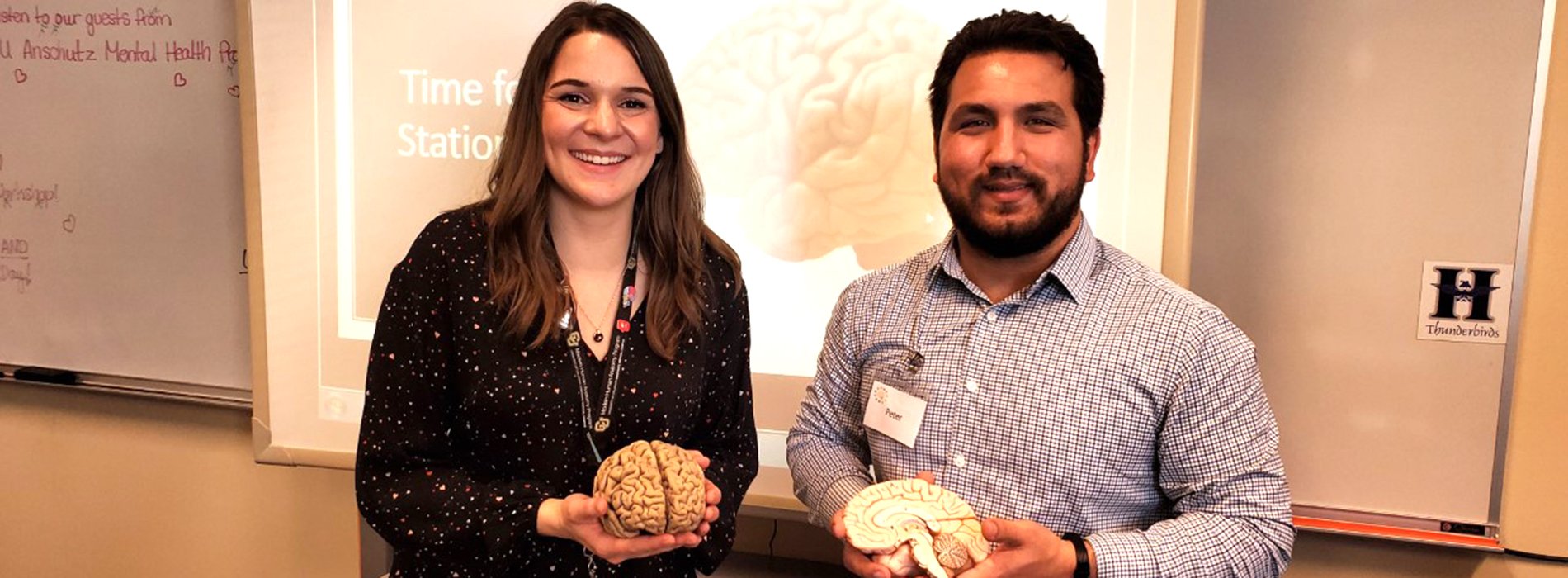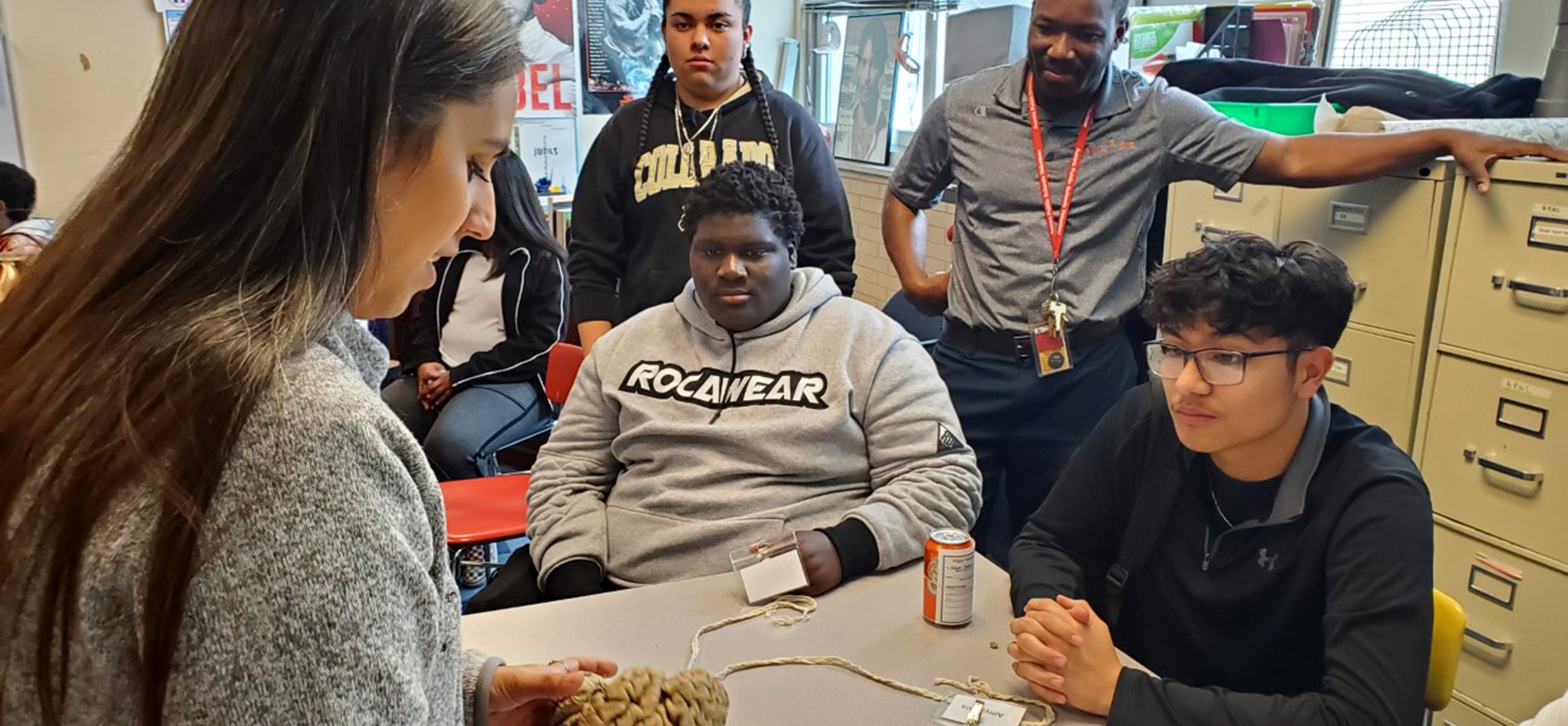Armed with colorful graphics, jars of beads and pieces of string, a team of University of Colorado Anschutz Medical Campus students filed into a high school classroom on Valentine’s Day, prepped to lead their younger counterparts in a class-wide project. Their mission that day, however, had nothing to do with hearts. At least in the Cupid sense.
Brains ruled the Friday afternoon workshop at Hinkley High School in Aurora, where CU Anschutz students took aim at something much more serious than the arrow-toting matchmaker’s goal – a mental health crisis affecting the nation’s teens.
“We want you to know that mental illness is not your fault,” Modern Human Anatomy (MHA) master’s student Laura Finger told the class during her introduction. “It’s not a sign of weakness. It has to do with a chemical imbalance or something else going on in your brain,” said Finger, student director of the project, which includes workshops in high schools across the metro area.
CU Anschutz program targets teen suicide
Spearheaded by Cell and Developmental Biology Associate Professor Maureen Stabio, PhD, the project grew out of another successful program Stabio created that brings at-risk area middle-school students to the CU Anschutz Medical Campus to learn about neuroscience from her graduate students.

Modern Human Anatomy master's student Laura Finger and Peter Therriat, an MHA student volunteer, led a recent workshop targeting teenage suicide. CU Anschutz graduate students use real donor brains to teach the connection between neuroscience and mental illness.
“More than half of the middle-school students surveyed consistently said no one had ever talked to them about mental health,” Finger said. “We found that very concerning.”
One in five U.S. adolescents faces a mental illness at some point, many of them by age 14, and upwards of 70 percent of those teenagers never receive professional help. Stabio and team garnered the additional funding through the MaggieGeorge Foundation and a CU School of Medicine Medical Student Council innovations grant for the mental health component.
The CU Anschutz program’s reach continues to grow, which Stabio credits largely to its community partner: the nonprofit Colorado Uplift, which mentors and guides about 3,800 youth in the metro area toward graduation and successful careers. The Hinkley visit marked the mental health program’s first time in an Aurora school.
Colorado outpaces the nation in youth suicides, the No. 1 cause of death for ages 15 to 24 in the state compared with the No. 3 cause nationwide. Program volunteers hope that by teaching students about mental disorders and their physical connections, they can reduce the stigma that prevents this vulnerable age group from seeking help.
Beads, brains and neurotransmitters
“Does anybody want to hold a brain?” Katy Ganser, a second-year Physician Assistant (PA) Program student, asked a group of teenagers huddled around her to learn about depression. As the high schoolers passed around the human donor brain (all gingerly, as directed, some hesitantly, because of a gross factor), Ganser launched into her lesson.

CU Anschutz physician assistant student Ferougg Khaaliq captures her audience's attention using a donor brain as a teaching prop.
“We have these little molecules in our brains called neurotransmitters. They’re like teachers almost. They run around and tell the cells what to do,” said Ganser, who joined some of her PA peers and some medical students in volunteering this year.
“Serotonin is the neurotransmitter we think makes you happy,” Ganser continued, explaining one depression theory. “In a normal brain, this would be serotonin,” she said, holding up a jar full of colorful beads. “With depression, you don’t have enough,” she said, picking up another jar, only a quarter full of less-colorful beads.
Ganser explained other depression theories and treatments, comparing real brain scans pre- and post-treatment to illustrate how therapy works.
“If you are depressed nearly every day, you should talk to a teacher or someone,” Ganser said. “Often times at your age, it can be irritability, especially in boys,” she said, listing a number of signs she asked the students to watch for in their selves and friends.
“The moral of the story is that depression is a chronic illness, just like asthma,” Ganser said, as students grabbed pamphlets with local crisis resources and numbers they could text for quick professional help before moving to their next station. “And we can treat it,” she said.
Outreach program aims at hitting all the bases
The four-station workshop also covered anxiety, stress and sleep, with CU Anschutz students honing teaching skills while using hands-on techniques, age-appropriate examples, and captivating props to illustrate how they all tie together in affecting mental health.
Offering coping skills and tips, the graduate students focused on teaching mental well-being. Lessons on deep breathing (“Think of your belly as a balloon”), tips on sleeping (“I use a podcast called Headspace before I fall asleep”), and a handful of resources (sleep journals, workbooks, stress balls shaped like brains) are program staples.
As part of the program, volunteers from the CU Anschutz Helen and Arthur E. Johnson Depression Center trained Colorado Uplift teachers in suicide prevention. At least one high school principal has since asked the center to train all of its teachers, Stabio said.
“I wish I had something like this when I was going through high school,” said Peter Therriat, MHA student volunteer. “I think I went through some of the same things a lot of these kids have gone through, and I can see myself in them.” Therriat often leads the depression station during workshops, where he has had influence, particularly with boys, he said.
“Typically, it’s the quieter ones that you don’t think are paying attention who come up to you afterwards who have the real questions,” Therriat said. “If we can reach even one or two, then we’re doing a good job.”
Want to help the program? Here’s how.
Anyone interested in donating funds toward the anatomy program’s plastination library may contact Laura Borbely in the Office of Advancement at laura.borbely@cuanschutz.edu or (303) 724-7820. Funds support the safe preservation of donated human organs for advancing education on our campus and in our community.
Photo at top: Katy Ganser, a second-year physician assistant, uses jars of beads, donor brains and real scans to illustrate the neuroscience behind depression.



